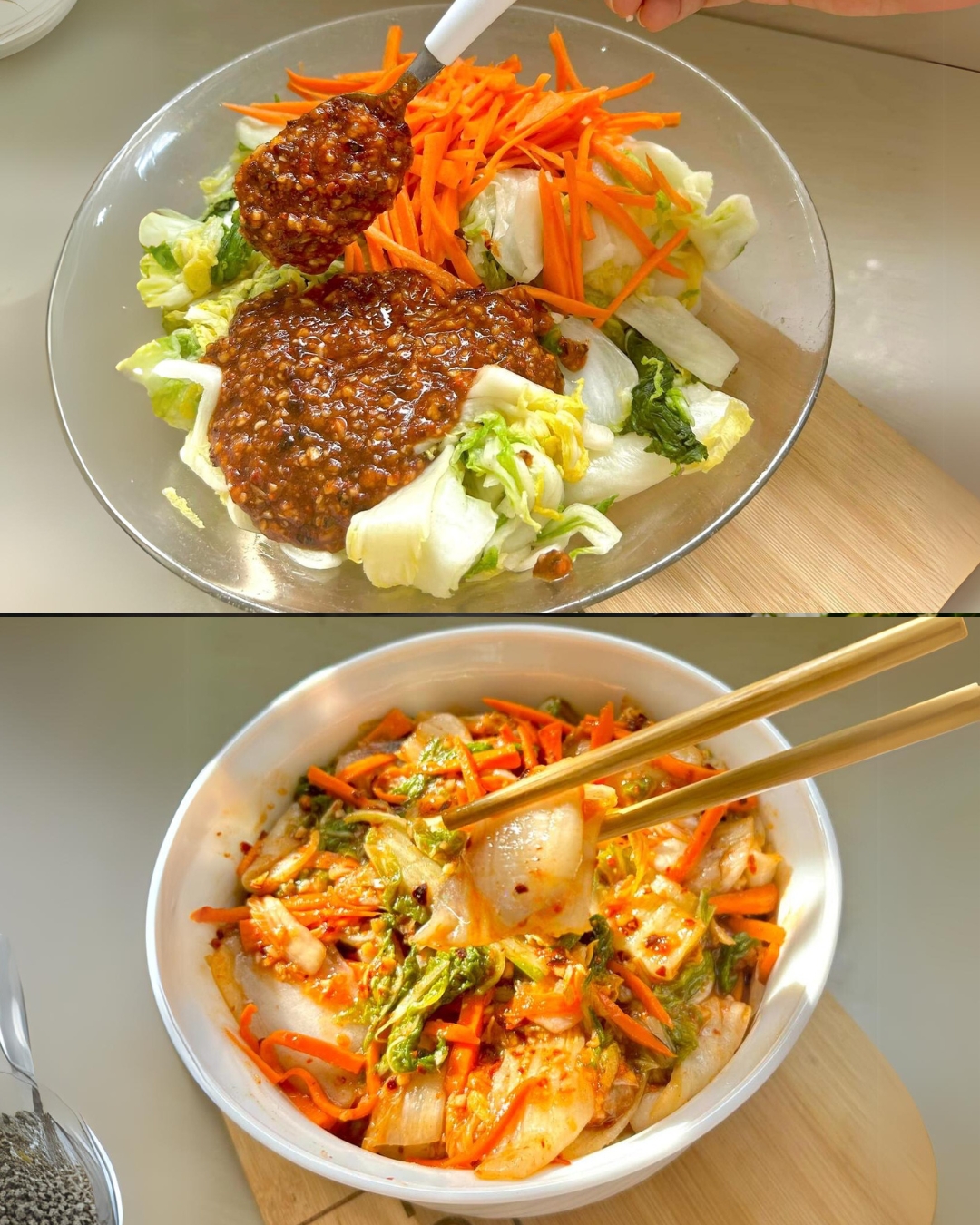This Korean-style kimchi recipe is a delicious, spicy, and flavorful dish made with Napa cabbage. The fermentation process, which involves soaking the cabbage in salt and then combining it with a spicy gochugaru-based sauce, results in a tangy, savory dish that’s a staple in Korean cuisine. Perfect as a side dish or topping for rice, kimchi also pairs wonderfully with grilled meats, tofu, or even as a filling for wraps and sandwiches. This recipe brings a burst of flavor and a kick of heat to your meal, making it a fun and unique addition to your cooking repertoire.
Preparation Time
- Prep Time: 20 minutes (excluding overnight soaking)
- Cook Time: 10 minutes
- Total Time: 30 minutes
Ingredients
- 1 Napa cabbage (sliced into preferred size)
- 2 tablespoons gochugaru flakes (or fresh red chili)
- 1 tablespoon grated ginger
- 2 cloves grated garlic
- 1-2 carrots (sliced)
- 2 tablespoons patis (fish sauce)
- 3 tablespoons brown sugar
- 2 tablespoons glutinous rice flour
- 1/4 cup water
- Salt (for soaking cabbage)
Directions
1. Prepare the Cabbage:
- Slice the Napa cabbage into your preferred size.
- Wash and dry the cabbage thoroughly.
- In a bowl, sprinkle salt generously over the cabbage, ensuring all the leaves are covered. Let the cabbage soak in salt overnight to draw out excess moisture.
- The next day, wash the cabbage thoroughly to remove excess salt and let all the liquid drip off. Set the cabbage aside to prepare for mixing.
2. Prepare the Glutinous Rice Flour Mixture:
- In a pan, dissolve 2 tablespoons of glutinous rice flour in 1/4 cup of water.
- Cook on low heat and bring to a boil, stirring continuously until the mixture thickens to a paste-like consistency. Once thickened, remove from heat and set aside.
3. Prepare the Sauce:
- In a bowl, combine 2 tablespoons of patis (fish sauce) and the grated garlic.
- Add 1 tablespoon of grated ginger and 2 tablespoons of gochugaru flakes to the mixture.
- Add 3 tablespoons of brown sugar and the thickened glutinous rice flour mixture.
- Mix thoroughly until the sauce is well-combined. Taste and adjust the amount of ginger, gochugaru powder, and sugar according to your preference for spiciness or sweetness.
4. Combine and Serve:
- Prepare the cabbage and add the sliced carrots.
- Add the prepared sauce to the cabbage and carrots, mixing well to ensure that the vegetables are fully coated with the spicy mixture.
- Serve immediately or refrigerate for a few hours to allow the flavors to meld together.
Serving Suggestions
- As a Side Dish: Serve kimchi alongside steamed rice for a traditional Korean meal.
- With Grilled Meats or Tofu: Kimchi pairs perfectly with grilled meats, tofu, or stir-fries, adding a tangy contrast to the richness of the main dish.
- As a Filling: Use kimchi as a filling for wraps, tacos, or sandwiches to add a spicy kick to your meal.
- In Soups or Stews: Kimchi can also be added to soups or stews for extra flavor, particularly in Korean dishes like kimchi jjigae (kimchi stew).
Cooking Tips
- Ensure Even Salting: When salting the cabbage, make sure that each leaf is evenly coated to ensure proper wilting and flavor absorption.
- Adjust Spiciness: Gochugaru flakes can vary in heat, so adjust the amount according to your tolerance for spiciness. You can always add more if you want extra heat.
- Resting Time: Although you can serve the kimchi immediately, letting it rest in the refrigerator for a few hours or even a day enhances the flavors and gives the kimchi time to ferment slightly.
Variations to Try
- Add Other Vegetables: You can experiment with adding other vegetables like radishes, green onions, or even cucumber to make your kimchi more colorful and varied.
- Vegan Option: Skip the fish sauce (patis) and use a plant-based alternative like soy sauce or tamari for a vegan version of kimchi.
- Spicy Kimchi: Add more fresh chili or gochujang (Korean chili paste) for a deeper spice and complexity in the flavor.
Nutritional Benefits
Kimchi is rich in probiotics, which promote gut health and digestion. The fermentation process increases the availability of beneficial bacteria, which support a healthy digestive system. It’s also packed with vitamins A, C, and K from the vegetables, as well as antioxidants from the gochugaru and garlic. This dish is low in calories, making it a great addition to a balanced diet, and its spicy nature can help boost metabolism.
Conclusion
This Korean-style kimchi made with Napa cabbage, gochugaru, and a simple yet flavorful sauce is a must-try for anyone who enjoys bold, spicy flavors. Whether you’re serving it as a side dish, topping, or snack, it’s a nutritious and delicious way to spice up your meals. Easy to prepare and full of flavor, this kimchi will bring a taste of Korea to your kitchen.
Frequently Asked Questions
-
Can I use regular cabbage instead of Napa cabbage? Yes, you can substitute Napa cabbage with regular cabbage. However, Napa cabbage is traditionally used for kimchi due to its tender texture.
-
How long does the kimchi last in the refrigerator? Kimchi can last for up to a week in the refrigerator. As it ferments, the flavor may intensify, so you can enjoy it over a few days.
-
Can I make kimchi without the fish sauce (patis)? Yes, you can substitute the fish sauce with soy sauce or a vegan alternative to make the kimchi plant-based.
-
How spicy will this kimchi be? The level of spiciness can be adjusted based on your preference. Add more or less gochugaru (Korean chili flakes) to control the heat.
-
Can I make this kimchi in advance? Yes, kimchi can be made ahead of time and stored in the refrigerator to allow the flavors to develop over time. It gets better as it ferments!

